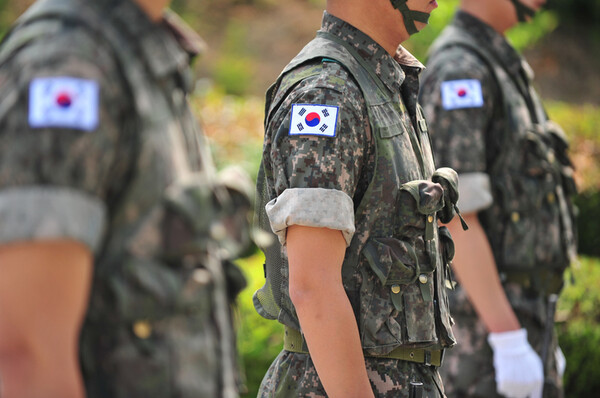An army recruit who collapsed and died during a military discipline drill (punishment) has been presumed to have died of “heatstroke,” prompting criticism about initial field responses.

Some critics attributed the incident to a failure to transfer the trainee to higher-level medical institutions within the “golden time.” However, experts pointed out that it was due to the poor military medical system that could not appropriately respond to heat stroke in the initial stage.
According to the Ministry of National Defense, an army trainee, initialized as Mr. A, collapsed while receiving a group punishment at an infantry division in Inje, Gangwon Province, at around 5:20 p.m., last Thursday. After receiving first aid to lower his body temperature, including fluids, from a military doctor, he was urgently transported to Sokcho Medical Center by ambulance with the military doctor at around 6:40 p.m.
When Mr. A arrived at Sokcho Medical Center, his fever had risen to 40.5 degrees Celsius, and he was reportedly suffering from multiple organ damage. Mr. A, who showed symptoms of kidney failure due to rhabdomyolysis, needed kidney dialysis. However, there was no kidney dialysis machine at Sokcho Medical Center, so he was transferred to GangNeung Asan Hospital, a neighboring tertiary general hospital, at around 9:40 p.m. He died two days later.
“Rhabdomyolysis can be caused by intense muscle exercise so that it can be seen in civilian hospitals’ emergency room),” said an emergency medicine specialist who requested anonymity in a telephone interview with Korea Biomedical Review. “If the trainee underwent a pack drill, he may have developed rhabdomyolysis, but he would not have died in two days due to kidney failure.”
“The military's initial response was more important than how quickly dialysis was administered,” the specialist said. “The temperature was high on the day of the exercise. They should have prepared to respond to heat stroke. When I arrived at Sokcho Medical Center, the recruit’s temperature was over 40 degrees. Unfortunately, they failed to recognize it as heat stroke and actively try to cool him down early on.”
The specialist continued, “I am also disappointed with the military medical system. Would they transfer wounded soldiers to civilian hospitals if war breaks out? In particular, the military environment is bound to have many heatstroke cases, and the lack of response shows that the military medical system is poor.”
The Korea Disease Control and Prevention Agency also reported Mr. A as the first heat illness death this year.
Critics also pointed to the “inadequate” military medical system, saying that even though there was a military hospital near Inje, the trainee had to be transferred to a civilian hospital. There are 13 military hospitals under the Armed Forces Medical Command in Korea, including three in Gangwon Province, where the incident occurred. Still, Mr. A was transferred from Sokcho Medical Center to GangNeung Asan Hospital.
“No military hospitals were involved in the death of the trainee. The young soldier had to skip no fewer than 13 military hospitals and went from Sokcho Medical Center to GangNeung Asan Hospital,” said Yang Seong-kwan, chief of the Family Medicine Department at Paik Hospital in Uijeongbu, on Facebook. “The key point that is being missed in this case is the military hospitals that are in name only and the inadequate military medical system.”
“A few months ago, these military hospitals launched a massive advertisement claiming to open their doors to civilians. They were making a show of treating civilians when they couldn't even caring soldiers properly,” Yang said. “Some policymakers also raised their voice to build a new National Defense Medical University when they couldn't even treat soldiers, which is the fundamental purpose of military hospitals.”
Yang continued, “In Korea, the first class of medical care is civilian, the second class is public medical care, and the third class is military medical care. This incident showed that. The third-class military hospital was 'passed over,' and the public hospital, Sokcho Medical Center, sent its patients to the civilian GangNeung Asan Hospital. I pray for the young recruit who unfortunately died while fulfilling his duty of defending the country.’
Other critics claimed that the government, which activated an emergency medical care system after a mass resignation of trainee doctors in protest against the increase in medical school enrollment quotas, has created a hole in the military medical system by dispatching military doctors to civilian hospitals.
“The distance between the frontline division and the Armed Forces Hongcheon Hospital is only 66 kilometers, which takes 60 minutes,” Lim Hyun-taek, president of the Korean Medical Association, said on Facebook. “The military doctors who were selected to save the soldiers were all sent to civilian hospitals, and the young soldiers who got sick were killed transiently.”
The KMA head denounced Second Vice Minister of Health and Welfare Park Min-soo as a politicized bureaucrat who effectively killed the trainee and criticized Minister of National Defense Shin Won-sik for condoning it.
“They should be punished for murder,” Lim said.
Related articles
- Trainee doctors to file ₩100 bil. lawsuit against President Yoon, ministers
- Foul-mouthed, conflict-mongering KMA head emerges as medical community’s biggest risk
- Seoul denies ties between public doctor decline and medical student increase policy
- Medical students on leave of absence join army instead of returning to school

